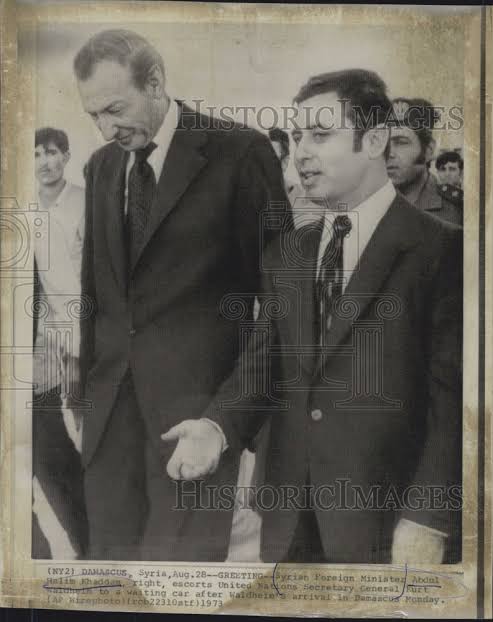Present:
His Excellency, Abdul Halim Khaddam Deputy Prime Minister and Minister for Foreign Affairs
Ambassador Salah Tarazi
M. D.A. El-Fattal
Dr. R. Jouejati
M. Riad Siage
The Secretary-General
Roberto E. Guyer
Brian E. Urquhart
James O.C. Jonah
1 – Foreign Minister Khaddam reiterated the position of his Government regarding UNDOF’s authority in supervising the Syria/Israel
Disengagement Agreement.
Specifically he underlined that UNDOF had no authority to control civilians entering the zone of disengagement.
There was a fundamental difference between UNEF and UNDOF; Syrian authorities, during discussions with Secretary of State Kissinger
leading up to the agreement, made sure that UNDOF was different from UNEF.
In the view of the Syrian Government UNDOF was only an observation force which must at all times carry out its mandate in compliance with Syrian laws and regulations.
Consequently, UNDOF could not operate in a manner contrary to basic agreements signed by Syria.
2.-With specific reference to the validity of the statement of the Chairman read out at Geneva, Foreign Minister Khaddam repeated that
Syria did not consider the statement as having any legal force, Only agreements signed by Syria were binding.
3.Foreign Minister Khaddam then turned his attention to an earlier Syrian request to General Siilasvuo for the destruction of fortifications
within the zone of disengagement that had been occupied by Israeli forces prior to the disengagement agreement.
He stated that he failed to understand the refusal of General Siilasvuo to destroy these fortifications in view of Syria’s pledge that it would be prepared to construct, at its own cost, new observation posts required by UNDOF.
Syria remained concerned that if the fortifications were not destroyed Israel would reoccupy them in the event of resumption of fighting.
UNDOF should not be placed in a position in which it was the guardian of Israeli fortifications to be reoccupied later by Israeli forces.
He pleaded with the Secretary-General to see to it that these fortifications were destroyed.
4.The Secretary-General expressed his satisfaction that Foreign Minister Khaddam was meeting with him to explain his Government’s
position.
He emphasized that it was essential to receive the full co-operation of all the parties concerned so as to ensure the smooth functioning of peace-keeping forces.
With regards to the problems raised by Foreign Minister Khaddam he noted that one main difficulty was that the United Nations was not present when the details of the disengagement agreement were being negotiated.
When differences of interpretation regarding UNDOF’s method of operation had arisen, it was thus necessary to obtain certain clarifications from Dr. Kissinger so as to have a correct interpretation.
Kissinger had affirmed that there was an understanding that UNDOF should have the right to control civilians entering the zone of disengagement.
This view had also been confirmed by Mr. Sisco. Both had insisted that UNDOF should not change procedures that had been in existence for the previous three months and that UNDOF had not only the right but an obligation to control civilians.
The Secretary-General, therefore, appealed to Foreign Minister Khaddam to understand the dilemma in which the United Nations was placed.
5. The Secretary-General took the opportunity to reiterate his regret for the unfortunate incident involving Defense Minister Tlas.
He noted that he had already dispatched a letter to President Al-Assad on the matter, he gave assurances that instructions had been given
in order to avoid such incidents in the future. Regarding the larger problems, it remained his hope that efforts would be made to find a
practical solution.
6. In response .to the Secretary-General’s remarks, Foreign Minister Khaddam stated that Dr. Kissinger had not been given any authority
to interpret any provisions of the agreement.
As far as Syria was concerned, it would not permit UNDOF to violate its laws and regulations.
He again intimated that Syria would be reluctant to agree to the renewal of UNDOF’s mandate should UNDOF persist in its present
method of operation. Syria had already taken a political decision which was in conformity with the signed agreements.
He went on to observe that Syria would not exchange an Israeli occupation force with a United Nations occupation force.
The only option open to Syria was to combat any such occupation force.
He, however, agreed with the Secretary-General that it was regrettable that the negotiations leading up to the disengagement agreement were conducted outside the framework of the United Nations.
7. When Foreign Minister Khaddam repeated Syria’ s concern that the fortifications within the disengagement zone had not been destroyed,
the Secretary-General stated that he would soon request General Siilasvuo to come to New York for consultations.
He was confident that a solution would be found on the matter which would be to the satisfaction of Syria.
8.The Secretary-General then examined the statement made by the Chairman in Geneva and drew attention to the fact that both General Tayara and General Shafir agreed to it.
Consequently, the United Nations had no alternative but to apply the provisions of this statement.
Foreign Minister Khaddam retorted by noting that General Tayara had not been given any authority by the Syrian Government to sign anything except the agreement and maps in Geneva.
The statement of the Chairman contradicted letters exchanged between Syria, Israel and Dr. Kissinger.
Therefore, the statement should not be relied on to interpret UNDOF’s mandate.
9. In view off the meeting of the Arab Delegations set for 5.00 P.m. was agreed that the discussions would be continued while Foreign
Minister 10haddam remained in New York. The Secretary-General repeated that General Siilasvuo would be coming to New York and that he hoped that a satisfactory solution would be found to the outstanding problems.
10.The meeting came to an end at approximately-5.15 p.m



